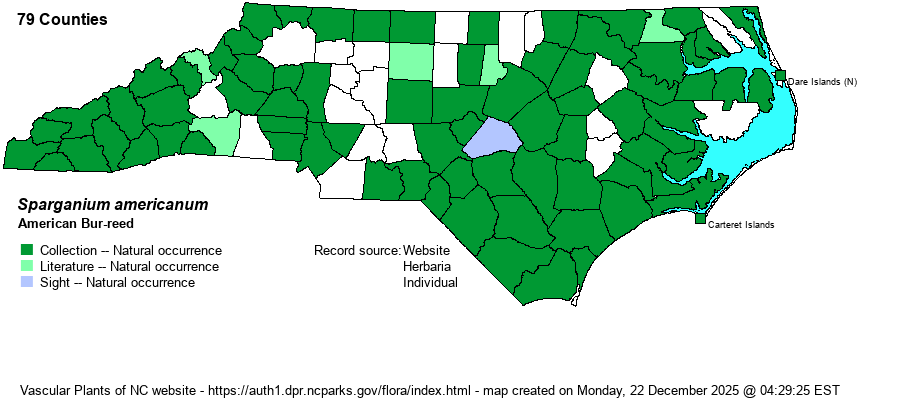| Author | Nuttall | |
| Distribution | Essentially statewide, but scarce in the central Piedmont, for uncertain reasons.
This is an Eastern species, ranging from eastern Canada south to central FL and eastern TX. | |
| Abundance | Common in the Coastal Plain, and in most of the Mountains. Fairly common in the eastern Piedmont, but mostly uncommon to infrequent in the central and western Piedmont. | |
| Habitat | This is a wetland to aquatic species, rooted under the water surface of streams, marshes, ponds, pools, beaver ponds, impoundment lakes, and other shallow fresh water. |
| Phenology | Flowers and fruits from May to September. | |
| Identification | This is a familiar semi-aquatic species -- growing in water but most of the plant is above the surface -- across the state. It has a quite stout stem, reaching 2 feet tall on average, rarely to 3 feet high. It has a few alternate leaves that are ascending, up to 2-3 feet long but only 1/2-inch wide, essentially strap-shaped, with a rounded tip. The inflorescences are from the leaf axils, simple or branched, from 1-6 heads or "balls" of flowers in a globose shape, white in color, each about 1 inch across, on a zigzag stalk. When these balls of flowers/fruit are visible, this is a very easy species to identify. However, some plants may be sterile or at least not flowering, and you will have to try to identify them by the long and narrow strap-like leaves. At times all of these leaves are submerged, but the rounded tips should be helpful in the identification. For separation from the rare-in-NC S. acaule, see that species account. | |
| Taxonomic Comments | Weakley (2018) lists no sub-taxa, but some references do, and there is much variability within this species.
| |
| Other Common Name(s) | None | |
| State Rank | S5 | |
| Global Rank | G5 | |
| State Status | | |
| US Status | | |
| USACE-agcp | OBL link |
| USACE-emp | OBL link |

